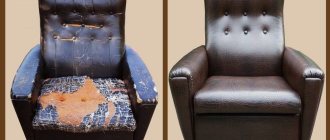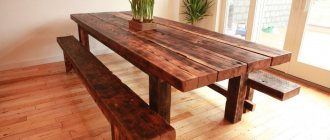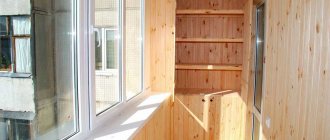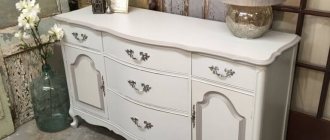How to make decoupage: instructions for beginner needlewomen
Decoupage is a simple technique for transforming things, which even novice needlewomen can handle. Now it is fashionable and interesting to engage in creativity. Almost everyone either sews or does embroidery. Decoupage is a method of decorating various surfaces by applying images that are printed using a printing method, and their further varnishing. But how to do decoupage? To master this simple task, you don’t need much time and effort, just a few tools and desire are enough.
The concept of decoupage technique
Decoupage is a technique for decorating objects by inserting a picture or drawing, followed by covering the glued composition with varnish or paint, ensuring the preservation of the created appearance of the object.
The beginning of decoupage dates back to the fifteenth century. This art originated in Germany - there are the first mentions of the technique. Cut out pictures were used to decorate furniture and create unique interior items. In Venice, elaborately carved images were used, covered with many layers of varnish.
The second flowering of the decoupage technique began in the Victorian era in England, from where decoupage as a hobby spread in the first half of the twentieth century. In Russia, there was a similar technique of icon painting, and decoupage itself was developed in the seventeenth and eighteenth centuries.
Basic moments
Decoupage is a special technology with which pictures from napkins or even postcards are transferred to the surface. There can be many variations, but beginners should know about the most popular movements:
Direct transfer is a decoupage technique for beginners. It is done very simply, the picture is applied to the finished surface, after which it is fixed with varnish or a special solution for decoupage.
Smoky – great for restoring old furniture without losing its identity. The drawing is in the style of old photos from the 30s.
Reverse – used when working with transparent surfaces. The picture will be glued to the outside.
Volumetric - allows you to create luxurious color compositions. Suitable for those who are already familiar with the technology and know the basic nuances.
Experts recommend starting with the first one – direct. The technique will allow you to hone your work with the material and composition. By the way, today, instead of regular varnish and glue, you can use a special solution that is sold in any craft store.
Photos of decoupage will help you find inspiration for creativity.
Advantages and disadvantages
Decoupage is an excellent method of decorating interior items. Like any decor, it has its own pros and cons that determine its use for decoration.
Advantages:
- the ability to use any material;
- ease of execution;
- availability of materials for work;
- high durability of most types of decor.
Decorative teapot
Decoupage is undemanding when it comes to the source material. Napkins, magazine clippings, and individual printouts are used as drawings. If you wish, you can cut out flowers from the wallpaper and place them on the cabinets - decoupage does not limit the author’s imagination.
Decoupage does not require any special skills or tools - all you need is scissors, an old magazine, varnish and a brush. In some cases, there is no need to carefully cut out the design, since some carelessness can add additional charm to the interior.
Varnish and paint are sold in any store. Decorating a wooden door will take no more than one 200 ml can of varnish.
On a paraffin candle
Almost all types of decoupage are durable due to varnish protection. Fragile works include those protected by other means or without protection at all. For varnished designs, the only threat is cracking over time.
Flaws:
- impossibility of application to all interior items;
- requirement for accuracy when working;
- difficulties when working indoors.
Not every piece of furniture is decorated using the decoupage technique for beginners. Step by step, with photos, we will analyze how bottles, fabric, plastic, cutting boards and other objects are decorated. Upholstered furniture or glass is not so easy to decorate. The varnish will not adhere to the fabric, and the glass will be damaged. In some cases this is not critical, but do not apply decoupage to glass in windows, since removing the varnish is extremely problematic.
Decoupage boxes
The surface for decoupage must be prepared - the old peeling layers of coating are removed from it. This applies to enamel on old furniture, which must be completely sanded.
To work, you need to be patient - delicate drawings require great care from the master when creating, since careless movement will easily tear the paper. This is critical when using thin paper.
Paint and varnish products have a specific smell that takes a long time to evaporate from the room. Considering that decoupage requires applying several layers of varnish, we recommend carrying out this operation outdoors.
Using paper
The situation is aggravated when it is necessary to sand the surface to begin work. With large sizes of the latter, a lot of dust and debris often form. This will put an end to the possibility of working indoors.
How can you do decoupage?
Each material, like each technique, has its pros and cons. So how can you do decoupage?
If you decide to do decoupage for the first time, then it is best to use special decoupage cards in your work
Decoupage is carried out using:
- Napkins;
- Decoupage cards;
- Rice paper.
Napkins have a big disadvantage: very often their motif and pattern is cut off and intertwined. Sometimes it is impossible to cut out part of a pattern without disturbing the integrity of the next one.
What you need to know before you start making decoupage
Before you start working with drawings, study the features of the fabrics and materials with which you will work.
A thick pattern for decoration looks less natural. This imposes restrictions on the use of thick cardboard and introduces its own requirements for the accuracy of work during the creation of the drawing.
Harmonious color combination
Not every drawing is located under varnish. The image must have solvent-resistant paints that will not begin to dissolve under the influence of the latter. Glossy designs are excellent, less so are images printed with inkjet ink.
Consider the combination of colors during decoupage for beginners (step by step instructions with photos below). Carefully select images for decoration, since an already fixed illustration is almost impossible to remove from the surface.
On a cutting board
Watch processing
The wooden base of the watch dial is usually renewed. First you need to disassemble the product into its components, separating the arrows and numbers.
The work is divided into 2 stages: decorating the circle along which the hands move, and the outer contour of the clock. The first part of the decoupage is updating the arrow space:
- a circle is cut out of paper;
- the dial is cleaned and puttied, if necessary;
- napkins or rice paper are glued onto the prepared plane, the pattern of which is made in a circle of paper;
- the picture is glued to the base, leveling the plane;
- the top of the napkin is treated with glue;
- after the workpiece has dried, the middle of the dial is covered with a paper circle, and the outer part is decorated;
- a structural paste mixed with acrylic paint of the desired color is applied to the surface;
- the finished surface is varnished 1-2 times and lightly sanded after drying;
- The watch is assembled by inserting the hands and numbers into place.
What you need for decoupage for beginners: a list to get started
For almost any type of decoupage, a standard list of materials and tools is sufficient. So, what do you need for decoupage for beginners - a list of things :
- drawing;
- scissors;
- glue;
- glue brush;
- varnish;
- varnish brush;
- sandpaper.
To make standard decoupage you need a drawing. It is selected in advance. Scissors are needed to cut it. For greater accuracy of work, use a stationery knife with a sharp blade, or special decoupage knives.
Set for decoupage
Be especially careful when choosing glue. You can also use regular PVA glue, but over time it will give the image a yellowish color. To get rid of the effect, choose a special glue that is sold in arts and crafts stores.
You should choose a special varnish - it is applied in thinner layers and does not use aggressive solvents that can damage the design. If you don’t have this, use regular varnish for wood or other material - it is selected depending on the material used.
Any brushes can be used, but for glue it is preferable to have several brushes of different sizes, allowing you to carefully apply it under the design.
Varnishes for decoupage
Sandpaper is useful to clean the surface from roughness before coating and process the varnish. We recommend using sandpaper of the least accessible fractions – 1600, 3200 and others. Too large will unnecessarily damage the varnish and surface.
Furniture Conversion for Beginners
Decoupage needlework allows you to continue using old furniture, updating its appearance beyond recognition.
- It is first recommended to disassemble the products into separate fragments. It is advisable to replace or clean the fittings. Glass surfaces must be degreased by treating with alcohol and dishwashing detergent without dyes.
- Metal products must be cleaned with an acidic solution (use vinegar and water in equal proportions). Then the dirt is cleaned off with a wire brush.
- Wooden products are processed with fine sandpaper to smooth out all the unevenness as much as possible.
- A primer is applied to the treated surface; after complete drying, it is recommended to clean the surface with zero-grade sandpaper.
Pictures-images are attached to the furniture surface in various ways:
- With the standard technique, renovation materials are glued to the surface of furniture fragments. After drying, the area is covered with several layers of colorless varnish.
- Reverse decoupage extends to the enhancement of glass surfaces.
- The artistic technique gives the effect of volume to the picture. In this case, manual shading of the colored background is performed, combined with the finishing of parts of the pattern.
- Using fragments torn out with uneven edges for decoration. Napkins, material that imitates the appearance of plastic, and designer paper are used.
- The volumetric technique uses fragments of napkins to create a unique finished picture. After the surface has completely dried, fragments of the image are drawn more clearly.
If polished furniture is being updated, it is recommended to first completely remove the shiny layer with sandpaper.
Decoupage for beginners: step by step with photos 7 master classes
Below are step-by-step instructions with photos. Decoupage for beginners will not seem so difficult if you adhere to the clear rules that we described below.
Another set for decoupage
Decoupage with napkins: step-by-step instructions
Napkins are a very affordable, but not the easiest material to work with. They have a beautiful pattern and look good as decoration, but leave unsightly folds.
To work you will need:
- napkin;
- water;
- flat surface for drawing;
- acrylic lacquer;
- brushes
Start by cutting out a design from a napkin. We recommend doing this with a stationery knife or a set of decoupage knives. The more accurately the design is cut, the better the quality of the finished element.
During cutting, the napkin will most likely begin to delaminate. Remove the layers without the image, leaving only the layer with the image. This will make the result more realistic.
| 1. Place the design on the surface - the napkin attaches perfectly to it. The approach allows you to completely get rid of all possible folds. | |
| 2. Wet the brush and begin to smooth out the design. | |
| 3. If any wrinkle appears during work, carefully lift the edge and smooth it out with a brush. The napkin will lie neatly without wrinkles. |
Wait for the water to dry. During soaking, the napkin will increase slightly in size, so take this into account when composing the composition.
Finally, coat the entire composition with varnish. The varnish depends on the type of surface. Acrylic varnish is universal. Apply it with a brush in one direction. The number of layers depends on the wishes of the master; 2-5 layers of varnish are enough.
The detailed process of decoupage with napkins is in the video below.
On wood
In the master class presented below we will talk about decoupage for beginners in wood. Step by step, with a photo in it, we will decorate a wooden panel. No special skills are required for the work, and all materials are sold in craft stores.
List to work with:
- tablet;
- rice paper for decoupage;
- green and white acrylic paints;
- acrylic glue and varnish;
- brushes
| 1. Work begins by painting the board with acrylic paints. Paint the front side and sides. | |
| 2. To highlight the main composition, paint the side in a different shade. White and green acrylic paint are mixed to create a softer shade. | |
| 3. While the board is drying, prepare your drawing. Tear the rice paper without fear with your hands - this approach eliminates noticeable transitions. | |
| 4. After the entire composition has been torn out, place it on a board and glue it with acrylic glue. It can be applied directly to the drawing itself. | |
| 5. After the glue has dried, add decorative branches. This is done with green acrylic paint. | |
| 6. Once the glue and paint are dry, begin applying varnish. The varnish is applied in one direction - for example, from top to bottom. | |
| 7. The last step is the addition of decorative beads applied to the acrylic varnish that has not yet hardened. | |
| 8. After the varnish has dried, the finished work is obtained. |
The video shows the complete process of creating a decorative panel using the decoupage technique.
Decoupage on fabric
Working with fabric is almost no different from ordinary decoupage; the main thing is to be as careful as possible while working. The master class tells how to use decoupage techniques to add a design to an ordinary bag, making it a work of art.
You will need:
- bag;
- a napkin with a suitable pattern;
- special decoupage glue for fabric;
- acrylic varnish for fabric;
- brushes
| 1. Work begins with trying on a napkin. It is important to make sure that it is the right size for the item. It's okay if she goes beyond his boundaries. | |
| 2. After trying on, cut out the design, which is subsequently placed on the bag. | |
| 3. Layer the napkin - take only the front part of the napkin, where the design is located. | |
| 4. Next, place the napkin on the bag. To apply the glue evenly, mark the borders. It is convenient to do this with pins, marking the edges of the future drawing. | |
| 5. Apply acrylic fabric decoupage glue to the fabric. It is sold in arts and crafts stores. Before applying glue, place cellophane under the fabric - multifors are suitable for this. | |
| 6. After applying the glue, place the picture. Smooth it out with a brush. Place the napkin perfectly evenly. | |
| 7. Ironing is done through a multifora - this way the napkin will stick well. After this, apply a special varnish glue. | |
| 8. Wait until the fabric dries. To enhance the effect, iron the design through a sheet of paper. | |
| 9. Then make other decorations - for example, embroidery along the edges of the design. |
Other features of the work are presented in the video, which makes it possible to create exactly the same bag.
On plastic
The master class explains how decoupage is done on plastic. An old computer mouse is used as a basis, which will become a pleasant element of room design.
Tools and materials:
- mouse;
- synthetic water brush;
- acrylic lacquer;
- napkin with a pattern;
- PVA glue;
- stationery knife.
The work begins with processing the plastic. It often becomes contaminated with grease, so wash it well and treat it with alcohol. This will get rid of excess fat, which will damage the fragile design on the napkin.
| 1. Cut out the design. Layer the napkin, removing excess layers under the pattern. After cutting the napkin, this is easy to do. | |
| 2. The next step is placement. Place the design in the desired location and smooth it with water. Water will soften the napkin and make it more flexible for the following operations. | |
| 3. Glue the design using PVA glue or decoupage glue. The latter is better because it does not leave a yellow tint, but in the absence of it, other adhesives can be used. | |
| 4. Apply acrylic varnish in several layers - the next layer is laid after the previous one has dried. This provides durability to the coating. After the varnish has dried, cut the pattern at the joints of the keys with a regular stationery knife. |
More details about decoupage on plastic in the video below. It is permissible to use this method with any plastic – the main thing is to degrease it first.
Decoupage cutting board
Creating a board using the decoupage technique is almost no different from creating a panel. The technique is similar and the only differences are in the material used.
You will need:
- uncoated wooden board;
- a napkin with a suitable pattern;
- acrylic paints;
- PVA glue;
- brushes and sponge.
| 1. Prepare the board. To do this, paint one side of it with acrylic paints using a piece of sponge. | |
| 2. Wait until the board is completely dry. At this point, prepare your drawing. As with any decoupage napkin, layer and cut or tear it to the desired size. | |
| 3. Glue the napkin with PVA glue. Apply it from the center of the design, smoothing it evenly and getting rid of wrinkles. | |
| 4. Since the drawing does not occupy the entire surface of the board, additionally paint over the free space. To do this, select acrylic paint to match the background color of the napkin and paint over the entire remaining space. It is permissible to work with an acrylic sponge. | |
| 5. When the paint is dry, coat the decoupaged side of the board with acrylic varnish. Cover with 2-3 layers - this will make the board more resistant to use. Use the other side of the board as usual. |
Decoupage bottles for beginners: step by step with photos
Working with glass is different from other materials. It is specially prepared for the job, since ordinary paint or acrylic varnish does not adhere to glass.
To complete the work you will need:
- bottle;
- napkin;
- acrylic primer;
- sponge;
- degreaser - solvent or alcohol;
- acrylic paint;
- acrylic lacquer.
Let's take a closer look at how bottle decoupage is done for beginners, step by step with photos and useful recommendations.
| 1. Degrease the surface with alcohol or acetone. It is important to wipe the entire surface - otherwise the soil will not settle on the glass. | |
| 2. Prime and paint the bottle. To do this, take an acrylic primer and mix it in half with the paint of the desired color. Apply priming using wet movements, leaving an equal layer of primer on the entire bottle. Cover the surface with paint of any color. | |
| 3. Prepare your drawing. This is done by peeling the napkin and cutting it into the necessary sections. After preparing them, start gluing - this is done with PVA glue. Glue it with gentle movements from the center to the edges, smoothing the napkin. | |
| 4. After the glue has dried, coat the entire bottle with acrylic varnish using a soft brush, creating several protective layers. |
Decoupage on glass
Decoupage on glass is one of the most difficult, as it requires great care in the work. Otherwise, the glass will become cloudy and lose its appearance.
For work, prepare:
- glass surface;
- napkins with the required pattern;
- decoupage glue and varnish;
- brushes
| 1. Work begins with preparing the surface - degrease it using any solvent (alcohol or acetone). Since the method does not involve coloring, immediately prepare the drawing - to do this, peel the napkin and tear out the drawing of the desired size and shape. | |
| 2. Afterwards, the drawing is located in the required place and glued. Work from the center outwards, leveling the napkin. Additionally, dry the drawing with a hairdryer - this will speed up the work process. | |
| 3. The last step is to cover the drawings with acrylic varnish. Any extension beyond the edges of the design is noticeable, so apply the varnish with due care exclusively to the design. Acrylic varnish is difficult to remove from the surface, so there is no room for error during coating. |
Wait for the varnish to dry and place a candle in the wine glass. The decorated piece acts as an excellent candle holder at night, creating stunning patterns in the room.
More details of the work in the video below - it shows the process of gluing and varnishing a glass.
Is it possible to decoupage a bathtub?
A cast iron bathtub can and even needs to be decorated when it begins to lose its original appearance.
Decoupage looks quite unusual and original in the bathroom interior
This is how it happens:
- The bath is degreased with alcohol or acetone;
- The motifs are detached from the napkins and glue is poured into the bowl;
- A piece of napkin is applied to a degreased surface and covered with glue using a brush. This way the entire outer part of the bathtub is covered with patterns from a napkin;
- After the glue has dried, the decorated areas are covered with acrylic varnish. At least 5 layers will be required, otherwise moisture will spoil the motifs in the future.
If you use this method of work, the design on the bathtub can last about three years.
To help beginners - from people with practice
Decoupage is a hobby with a lot of fans. Despite the apparent complexity, there are a large number of nuances that are not always available to beginners. Next we will talk about some of them.
What professional decoupage artists will tell us - reviews, recommendations
“Decoupage is a cheap and profitable hobby that requires almost no skills. But sometimes the work seems too deceptive. You should start learning technology with unnecessary things that you don’t mind spoiling. Don’t neglect special varnishes and adhesives - they allow you to do the work much more beautifully and accurately.”
Alla Nikitenko is a teacher of decoupage courses in Moscow with 5 years of experience.
“For me, the main advantage of decoupage as a hobby is its limitlessness - there are no restrictions for a decoupage artist, since the technique can be applied to almost any surface. You shouldn’t stand still - having completed one subject, start another, because only through practice does one gain mastery.”
Olga Ivanenko is a practicing decoupage artist with 4 years of experience.
TOP 5 mistakes
The list below was compiled by experts and allows you to learn about the most common mistakes when decoupage.
- Smoothing the pattern from the edges to the center. In this case, folds form on it. This is noticeable with napkins because they are soft and thin. When gluing the design, work exclusively from the center to the edges;
- When decoupaging glass or other smooth surfaces, be sure to use a primer. Neglecting it will negate all efforts - the varnish will quickly peel off the surface, ruining all the work;
- When choosing a pattern for decoupage, you cannot use thick patterns with smooth edges. Such notches are very noticeable - especially when viewed from the side. This will spoil the appearance of the product and make it unpleasant.
- Buy a special set of brushes for glue and varnish. Using natural brushes for varnish leads to damage to the appearance due to destruction of the fiber, and using synthetics for glue leads to damage to the design. Mixing glue and varnish on the same brush leads to unpredictable results.
- When working with napkins, cut them after delamination. Otherwise, the drawing will shift relative to the lines and deteriorate, becoming unsuitable for further work. When using glossy images, first coat them with water, releasing the tension on the surface layer.
The essence of art
The basis of needlework is gluing a selected pattern (special or regular napkins, newspaper or magazine paper, fabrics, other materials) onto the surface of almost any product with a dense texture. It is not allowed to use a porous plane. The background is usually painted white to preserve the brightness of the design.
Types of applied arts:
- The classic method of decoration involves gluing a picture onto a smooth surface. Various reliefs, slopes, and curves are excluded. After gluing the pattern, the product is treated with several layers of varnish. Then the errors are sanded down with sandpaper to a uniform coating. If necessary, techniques of coloring, tinting, and artificial aging of the material are used.
- The reverse decoupage method is used for glass surfaces. In this case, the image in the figure is glued face down on the reverse side, and the order of work is performed in the reverse order.
- Volumetric technique combines the techniques of artistic painting and sculptural creativity. In this case, a three-dimensional panorama is recreated on the surface of the object.
- The smoky pattern involves a complete combination of motifs on the background and image. As a result, the work is similar to the artist’s original painting.
The decopatch technique is reminiscent of a patchwork quilt, in which the storyline is created from multi-colored images of different sizes that are not connected by color or theme.
Despite the variety of techniques, needlework is quite accessible to beginners who have decided to take up decoupage for the first time.
Decoupage courses in Moscow for beginners - school addresses
We offer you a list of decoupage courses in Moscow for beginners that will teach you this technique:
| Name | Metro | Address | Contacts | Price |
| Creative development courses in Cultural | Kursk | st. Staraya Basmannaya, 12, building 2 | +7 | 5800 rub. |
| Decoupage on wood | Belarusian | st. 2nd Brestskaya, 39, building 3 | +7 | 1500 rub (3 hours) |
| Creative workshop “Golden Hands” | by appointment | by appointment | 8(495)703-71-01 | 2500 rub (6 hours) |
| Handicraft gallery “Forget-me-not” | Nagornaya | Khlebozavodsky proezd, 7С9 | 8 | RUB 11,250 (for the entire course) |
| Art studio “OSA” | Elektrozavodskaya | Perevedenovsky lane 18, building 2 | 8 8 | 6000 rub. (4 lessons of 3-4 hours) |
Decorating with smoky decoupage
The technique is complicated by the fact that you have to work with small parts. There is no need to worry, even a person who does not have an art education can handle it. However, you will have to be patient; the process, although entertaining, is complicated.
How to do it:
- Surface preparation occurs according to an already known system. Boxes and furniture are usually decorated and restored in this style.
- You need to buy good brushes, paint and a special retarder.
- The difficulty is that after transferring the picture, choose the right shades and do the shading.
You can get acquainted with the details and main nuances from the course. In the video you can see how the artist creates the “smoky” effect of antiquity.
Photo gallery
With Easter eggs
Family heirloom
Ladies handbag
Women's comb
Chest of drawers for home
Clock
small chest of drawers
Home style
Watering can for a summer residence
Women's shoes
Stool for the kitchen
Women's mirror
Sweets box
Book stand
Decorating the surface using newspaper
An old coffee table can also be given a modern and interesting look. To do this, you will need several old newspapers, maybe even with a picture, a little varnish, white matte paint and brushes. How to do it:
- The table is processed using sandpaper. It is advisable to cover with primer; drying will take several days.
- Next, the surface is covered with paint.
- After which, you can transfer the drawing from old newspapers.
Even if the work is not done very carefully, the finished product still looks very impressive. This table can decorate any modern living room.
Doing it right: decoupage wood with napkins step by step
Work on decorating wood must be done carefully and in accordance with the instructions. At the same time, you should not be afraid to work with paper - even if the napkins are torn, they can easily be glued to the product and the “breakage” will not be noticeable. To get started, separate the top layer from three-layer napkins.
The napkins are cut into pieces of the required size. If there are unnecessary inscriptions or numbers on the napkin, they can be cut out or carefully torn out by hand.
After the fragments are ready, they need to be “tried on” to the object being decorated. This will help avoid problems with decoupage. After this, you can start gluing the napkins.
A soft brush is indispensable when decoupage, which helps to quickly apply glue to the surface.
Step-by-step actions:
- Using a soft brush, apply glue to the napkins.
- The fragment is applied to the product.
- Leave the product to dry for half an hour.
- Dry the surface with a hairdryer.
- Paint over it with acrylic paint of a suitable color.
The final stage is coating the product with acrylic varnish. The varnish can be applied in one or two layers. Decoupage with napkins is very easy to do - even a beginner can handle this task.
Simple wood decoupage for beginners: napkins and general instructions
The decoupage technique appeared in the 17th century. This type of decoration has become so popular today due to its ease of execution. There are many types of materials that decorate, as well as a wide variety of materials used to produce decoupage.
Creative work begins with choosing the item that will be decorated. When it comes to wood, the choice is very large: from boxes and trays to pieces of furniture.
Before starting work, beginners need to familiarize themselves with the instructions and general rules that apply to all decoupage techniques. You should also prepare the necessary tools and materials, without which high-quality decoration will be impossible.
Before you start decoupage, you should definitely prepare the wooden surface
What you should pay attention to:
- Preparing the wooden surface;
- Study of issues related to sealing joints and irregularities;
- Selecting the type and quality of surface primer.
Preparatory work is extremely important, since the quality of the decorated surface depends on it. All stages of work must be performed carefully, in the exact sequence. Do not neglect the advice of professionals - small nuances can sometimes significantly simplify your work.
Decoupage: implanting a napkin into wood
There is a decoupage technique called “implanting a napkin” into wood. This technique is slightly different from simply covering a wooden product with napkins. It requires more serious preparation and elaboration of details. To “implant” the napkin you will need a fairly large amount of materials.
This technique involves the use of wax, acrylic primer, acrylic paint, varnish, glue, brushes, napkins, tape, wax polishing cloth, sandpaper.
Before starting the main work, the tree must be carefully prepared. For this purpose, the technique of burning and brushing is used. You can find instructions for this technique on the Internet.
The technique of “implanting a napkin” into wood allows you to make a beautiful, original and unique product
How to perform “implantation” step by step:
- Rub dark wax into the wood.
- Sand the wooden surface.
- Apply the napkins and let them dry.
- Rub the surface of the product with dark wax.
- Coat the product with varnish.
This technique requires careful execution of the work. The appearance of the surface to be decorated depends on this. Master classes on “implanting” napkins into wood can be found on specialized websites.











